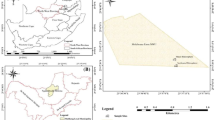Abstract
A novel degenerated primer set was designed to amplify acyl homoserine lactone (AHL) synthetase genes from members of the family Rhizobiaceae. The primer set successfully amplified AHL synthetase genes from pure cultures of AHL producers from Rhizobiaceae, but not from AHL producers out of the Rhizobiaceae family, indicating the specificity of this primer set to the Rhizobiaceae family. An inoculation experiment showed that the minimal detectable concentration of AHL producers from the soil was around 2.5 × 107 CFU/g soil. When applying to environmental samples, 7 and 14 different genotypes of AHL synthetase genes were identified in the rhizosphere of Glycine max and Vigna unguiculata, respectively, which revealed complicated and unknown AHL-based quorum-sensing networks in the rhizosphere. This is the first primer set that covers diverse AHL synthetase genes from different genera. It will be a useful culture-independent approach for better understanding of the ecological significance of QS in natural habitats.




Similar content being viewed by others
References
Hirsch AM, Bauer D, Bird DM, Cullimore J, Tyler B, Yoder J (2003) Molecular signals and receptors: controlling rhizosphere interactions between plants and other organisms. Ecology 84:858–868
Brencic A, Winans SC (2005) Detection of and response to signals involved in host-microbe interactions by plant-associated bacteria. Microbiol Mol Biol Rev 69:155–194
Fuqua C, Winans SC, Greenberg EP (1996) Census and consensus in bacterial ecosystems: the LuxR-LuxI family of quorum-sensing transcriptional regulators. Ann Rev Microbiol 50:727–751
Lumjiaktase P, Aguilar G, Battin T, Riedel K, Eberl L (2010) Construction of self-transmissible green fluorescent protein-based biosensor plasmids and their use for identification of N-acyl homoserine-producing bacteria in lake sediments. Appl Environ Microbiol 76:6119–6127
Wielbo J, Golus J, Marek-Kozaczuk M, Skorupska A (2010) Symbiosis-stage associated alterations in quorum sensing autoinducer molecules biosynthesis in Sinorhizobium meliloti. Plant Soil 329:399–410
Zhu H, Sun SJ, Dang HY (2008) PCR detection of Serratia spp. using primers targeting pfs and luxS genes involved in AI-2-dependent quorum sensing. Curr Microbiol 57:326–330
Kamlesh J, Kong R, Patole MS et al (2007) LuxRI homologs are universally present in the genus Aeromonas. BMC Microbiol 7:93
Lindemann A, Pessi G, Schaefer AL, Mattmann ME, Christensen QH, Kessler A, Hennecke H, Blackwell HE, Greenberg EP, Harwood CS (2011) Isovaleryl-homoserine lactone, an unusual branched-chain quorum-sensing signal from the soybean symbiont Bradyrhizobium japonicum. Proc Natl Acad Sci U S A 108:16765–16770
González JE, Marketon MM (2003) Quorum sensing in nitrogen-fixing rhizobia. Microbiol Mol Biol Rev 67:574–592
Vlamakis HC, Kolter R (2005) Thieves, assassins and spies of the microbial world. Nat Cell Biol 7:933–934
Huang YL, Zhang J, Yu ZL, Zeng YH, Chen YC (2012) Isolation and characterization of acyl homoserine lactone producing bacteria during an urban river biofilm formation. Arch Microbiol 194(12):1043–1048. doi:10.1007/s00203-012-0849-3
Huang YL, Zeng YH, Yu ZL, Zhang J (2013) Distribution and diversity of acyl homoserine lactone producing bacteria from four different soils. Curr Microbiol 66(1):10–15. doi:10.1007/s00284-012-0234-0
Acknowledgments
We would like to thank Prof Lizhong Zhu and Prof Baoliang Chen for their technical support and constructive discussion during the experiments. This work was financially supported by national natural science foundation of China (21137003, 21077090) and natural science foundation of Zhejiang Province (Y5100048) to Yili Huang.
Author information
Authors and Affiliations
Corresponding author
Rights and permissions
About this article
Cite this article
Huang, Y., Zeng, Y. & Yu, Z. A Novel Degenerated Primer Pair Detects Diverse Genes of Acyl Homoserine Lactone Synthetase in Rhizobiaceae Family. Curr Microbiol 67, 183–187 (2013). https://doi.org/10.1007/s00284-013-0351-4
Received:
Accepted:
Published:
Issue Date:
DOI: https://doi.org/10.1007/s00284-013-0351-4




